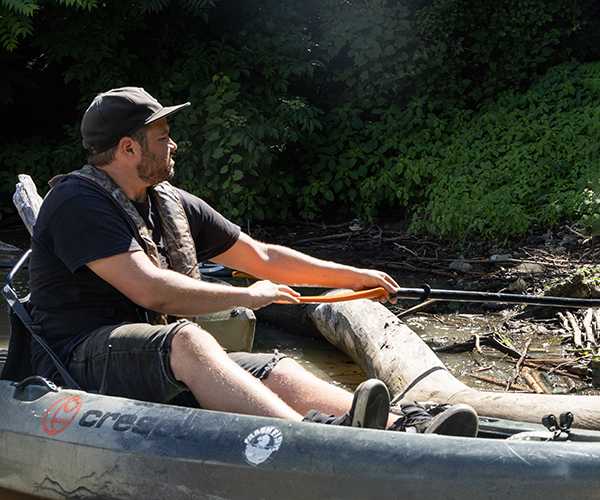The boxy beige Colonial could be confused with one of the remaining farmhouses on this lonely rural stretch of road if not for the sign: Tinkers Creek Road Tavern. The Walton Hills place has had several names throughout the years. “Hole-in-the-wall” would have fit until a few years ago.
It seems unimaginable today while kicking back on the tavern’s patio with a $9 martini: a fawn climbs a nearby embankment, kayakers navigate the creek’s shoaling water. Inside, the restored oak dining room and matching bar implies Tremont-trendy rather than old-school roadhouse. But nestled alongside the Cuyahoga Valley National Park, the tavern feels much farther away from downtown than the 12-mile separation suggests.
Mike Cahill, a Marblehead, Ohio, developer, anted up $500,000 three years ago and took a gamble on infusing the streamside saloon, which has one of the state’s oldest liquor licenses, with some beach-cottage class. Along the way, he gave new life to one of the oldest, rowdiest drinking holes most Clevelanders never knew existed.
Cahill shucked the tavern to its husk while restoring the 1902 structure — originally a private home and produce stand — to its Progressive Era roots. As he says, “Sometimes going forward means you have to go back.”
And the history goes back quite a ways. Walton Hills historical records show a cabin existed on the property as far back as 1813. But the colorful stuff came after the end of Prohibition let booze flow freely. During the 1940s, the place was known as Charlie’s, and it wasn’t uncommon for the dungeonlike basement to be used as an impromptu shooting range. “Anything went,” confirms Walton Hills historian Jeanne Kainsinger, explaining that the hilly terrain and miniscule police force gave Cuyahoga Valley farmers and horse riders the seclusion to play Midwest cowboys. “Just like Vegas, everything stayed there.”
Later, in the ’60s, when the taps spewed Genesee, the place was known as Tinki’s, and the wildlife was on the inside as much as out. There was a pet crow tied to the bar and tales of cockroach races. Cahill recounts these stories while showing off framed photographs of his tavern’s many incarnations and a sawed-off Louisville Slugger he says once served as “crowd control.”
But Jeff Alexander, the nephew of brothers Sam and Sebastian Parasiliti, who owned Tinki’s from 1963 to 2006, says the place wasn’t as wild as Cahill makes it sound. “He sure has an imagination,” Alexander says. He points to Sebastian’s widow, Shelby, a petite woman who still wears a strawberry beehive hairdo. “She was the bouncer for 40 years. How rough could it have been?”
Randy Westfall, the 59-year-old mayor of neighboring Valley View, cleared up the controversy for us: First, he says, there is something to all the rough talk, and second, he loved hanging out there. “A fight wouldn’t be anything unusual,” he says. Shelby used to listen to him lament his girl troubles as she tended bar, and when he and his friends drank too much 3.2 beer, “they had a quick fuse to throw us out of there.”
Decades changed, and Tinki’s chugged on mostly the same. But the bar was looking its age when Cahill bought it in 2006. While his showman side revels in the wild stories, Cahill the historian says it’s an honor to build his new legacy atop such a storied foundation of flowing alcohol and alpha males.
“It’s nice to take a little piece of the past and keep it alive just a little bit longer.”
It seems unimaginable today while kicking back on the tavern’s patio with a $9 martini: a fawn climbs a nearby embankment, kayakers navigate the creek’s shoaling water. Inside, the restored oak dining room and matching bar implies Tremont-trendy rather than old-school roadhouse. But nestled alongside the Cuyahoga Valley National Park, the tavern feels much farther away from downtown than the 12-mile separation suggests.
Mike Cahill, a Marblehead, Ohio, developer, anted up $500,000 three years ago and took a gamble on infusing the streamside saloon, which has one of the state’s oldest liquor licenses, with some beach-cottage class. Along the way, he gave new life to one of the oldest, rowdiest drinking holes most Clevelanders never knew existed.
Cahill shucked the tavern to its husk while restoring the 1902 structure — originally a private home and produce stand — to its Progressive Era roots. As he says, “Sometimes going forward means you have to go back.”
And the history goes back quite a ways. Walton Hills historical records show a cabin existed on the property as far back as 1813. But the colorful stuff came after the end of Prohibition let booze flow freely. During the 1940s, the place was known as Charlie’s, and it wasn’t uncommon for the dungeonlike basement to be used as an impromptu shooting range. “Anything went,” confirms Walton Hills historian Jeanne Kainsinger, explaining that the hilly terrain and miniscule police force gave Cuyahoga Valley farmers and horse riders the seclusion to play Midwest cowboys. “Just like Vegas, everything stayed there.”
Later, in the ’60s, when the taps spewed Genesee, the place was known as Tinki’s, and the wildlife was on the inside as much as out. There was a pet crow tied to the bar and tales of cockroach races. Cahill recounts these stories while showing off framed photographs of his tavern’s many incarnations and a sawed-off Louisville Slugger he says once served as “crowd control.”
But Jeff Alexander, the nephew of brothers Sam and Sebastian Parasiliti, who owned Tinki’s from 1963 to 2006, says the place wasn’t as wild as Cahill makes it sound. “He sure has an imagination,” Alexander says. He points to Sebastian’s widow, Shelby, a petite woman who still wears a strawberry beehive hairdo. “She was the bouncer for 40 years. How rough could it have been?”
Randy Westfall, the 59-year-old mayor of neighboring Valley View, cleared up the controversy for us: First, he says, there is something to all the rough talk, and second, he loved hanging out there. “A fight wouldn’t be anything unusual,” he says. Shelby used to listen to him lament his girl troubles as she tended bar, and when he and his friends drank too much 3.2 beer, “they had a quick fuse to throw us out of there.”
Decades changed, and Tinki’s chugged on mostly the same. But the bar was looking its age when Cahill bought it in 2006. While his showman side revels in the wild stories, Cahill the historian says it’s an honor to build his new legacy atop such a storied foundation of flowing alcohol and alpha males.
“It’s nice to take a little piece of the past and keep it alive just a little bit longer.”



